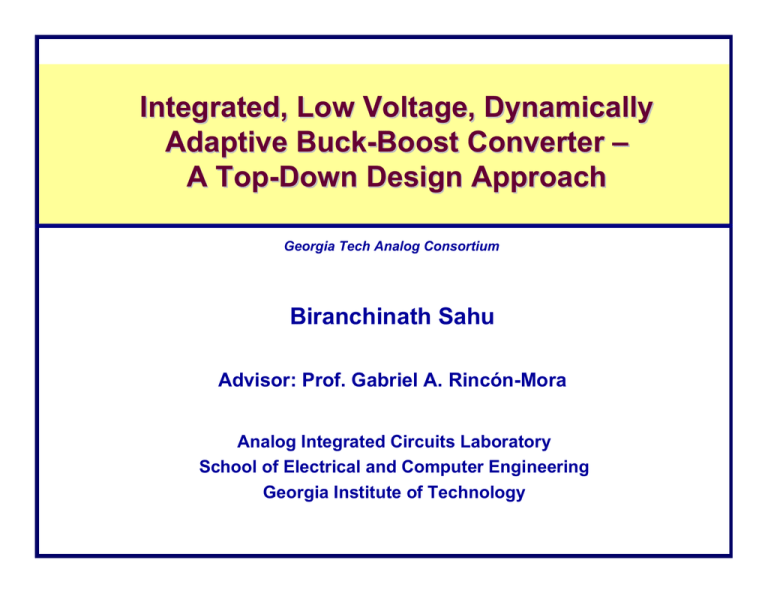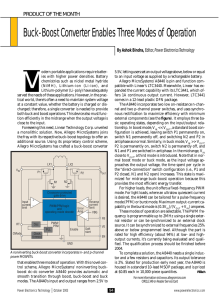Integrated, Low Voltage, Dynamically Adaptive Buck
advertisement

Integrated, Low Voltage, Dynamically Adaptive Buck-Boost Converter – A Top-Down Design Approach Georgia Tech Analog Consortium Biranchinath Sahu Advisor: Prof. Gabriel A. Rincón-Mora Analog Integrated Circuits Laboratory School of Electrical and Computer Engineering Georgia Institute of Technology Georgia Tech Analog Consortium 2 Abstract Power-aware, portable, electronic systems incorporate algorithms for dynamically changing the supply voltage depending on workload/throughput to extend battery life. Single inductor, non-inverting buck-boost converters are best-suited to generate a voltage that is higher and lower than the battery supply, with minimum number of external components. ⇒ Dynamically-Adaptive Buck-Boost Converters 9 9 9 9 High efficiency Low voltage Integrated Low noise ⇒ Improvement in battery life ⇒ Single cell operation (Li-ion/NiCd/NiMH/Fuel Cell) ⇒ ↓ External components, ↓ Cost ⇒ ↓ Interference This work addresses the design challenges and trade-offs involved in realizing an integrated circuit (IC) for such a system with a wide range of supply voltage. Lower limit – Minimum supply voltage for circuits to be operational (1.4 V) Higher limit – Process technology constraints (5 V) Biranchinath Sahu School of Electrical and Computer Engineering Georgia Institute of Technology Georgia Tech Analog Consortium 3 Understanding the Load Battery Supply 3.5 Non-inverting Buck-Boost DCDC Converter RF input Power Amplifier RF Output Load 3 Probability (%) Control Signal Output (0.5 – 5.0 V) Urban Suburban 2.5 2 1.5 1 0.5 0 -50 -40 The System -30 -20 -10 0 10 20 Output power (dBm) Loading Profile The output power of the power amplifier varies over a wide range ⇒ Output voltage range of the buck-boost converter For WCDMA architecture, the power transmitted can increase or decrease by 1-dB is every 666 µsec ⇒ Transient requirements The RF power amplifier must meet its adjacent channel leakage ratio (ACLR) and error vector magnitude (EVM) specifications ⇒ Output voltage accuracy (DC, AC, Transient) requirements Biranchinath Sahu School of Electrical and Computer Engineering Georgia Institute of Technology 30 Georgia Tech Analog Consortium 4 Requirements of the Converter Converter needs to satisfy transient requirements Under light-load conditions, the converter can operated in buck-mode with a lower switching frequency, thereby reducing switching losses and consequently improving system efficiency. Control signal 5V Converter output voltage Can be operated with low frequency, no need to meet any transient requirements Boost Buck-boost 0.5 V Buck - 50 dBm 10 dBm 27 dBm PA Output power 1 dB Tpower_change Output voltage Linearity degradation Tresponse Typical transient response Biranchinath Sahu Time Specifications Value Input voltage (VIN ) Output voltage (VOUT ) Load current [ILOAD = f (VOUT )] Output voltage accuracy [f (VOUT )] Load resistance Switching frequency Closed-loop bandwidth 1-dB step change response time Full-load efficiency 1.4 - 4.2 V 0.4 - 4.0 V 0.03 - 0.5A 95 % 10-15 Ohms 1 MHz ± 20% ≥ 50 kHz ≤ 20 µsec ≥ 90 % School of Electrical and Computer Engineering Georgia Institute of Technology Georgia Tech Analog Consortium 5 Converter Block Diagram Vin MP1 Vph1 L MN1 MN3 Vph2 Vout D2 MP2 D1 MN2 RESR ILOAD C Drive and dead-time control Error amplifier Drive and dead-time control COMPBOOST Duty cycle limit Feedback control Level shifting circuit Start-up and control signal by-pass circuit Salient Features → Voltage mode control → Type–III compensation → 1 MHz switching frequency → 0.8 µH power inductor → 10 µF output capacitor with 10 mΩ ESR Vcontrol COMPBUCK Triangular wave generator 1 Buck/Buck-Boost/Boost Mode1 of operation for improved efficiency Low power, sleep mode of operation for optimal efficiency FA7618 controller as presented in US Patent No. 5,402,060 (1995) and LTC 3440 application notes (2003). Biranchinath Sahu School of Electrical and Computer Engineering Georgia Institute of Technology Georgia Tech Analog Consortium 6 Dynamic Sizing of Power MOSFETS Common Drain Node 1.4E+06 1.2E+06 0.5 pF 1.0E+06 3.5 pF W/L Ratio Vsupply 0.35 V PMOS NMOS I II 8.0E+05 III 6.0E+05 IV 4.0E+05 2.0E+05 0.25 V 0.0E+00 0.2 V Gate Drive Signal UVLO Signal 0.175 V Battery State Monitoring Block Power MOSFET sizing strategy 1.4 2.1 2.8 3.5 Battery Voltage (V) Aspect ratio for same switch ON-resistance with variation in supply voltage Dynamic sizing of Power MOSFETs allow minimization of conduction and switching losses for optimal efficiency at a given supply voltage. Conduction loss ∝ Switch resistance ∝1/W Switching loss ∝ Switch capacitance ∝ W Biranchinath Sahu 4.2 School of Electrical and Computer Engineering Georgia Institute of Technology Georgia Tech Analog Consortium 7 Gate Drive Circuits VIN VGATE_MN3 VIN_MAX MN3 VOUT < VIN - VTN Vph2 Vph1 D2 L 2 Vout MP2 VGATE_MP2 RESR C MP2 OFF 2 MN2 OFF VIN_MIN VOUT_MIN Except the Boost PMOS switch, all the other switches can be driven by a chain of inverters. For the output switch, transmission gate is used to reduce the voltage range for which body diode conducts. The PMOS gate driver is powered from the output of the converter to ensure its operation. Biranchinath Sahu 1 VOUT > VIN - VTN IO Output Switch VOUT = VIN - VTN 1 |VTP| VOUT Transmission gate operation VOUT PWM Signal Level Shift Circuit PMOS Drive Circuit VGATE_MP2 VBAT NMOS Drive Circuit VGATE_MN3 Level shifting circuit for PMOS Boost Drive School of Electrical and Computer Engineering Georgia Institute of Technology Georgia Tech Analog Consortium 8 Designing the Error Amplifier Requirements of the Op-amp Input common-mode range (ICMR) With |VTP|+VTN > VDD, the ICMR of NMOS and PMOS exist only close to supply and ground rail, respectively. By dynamically shifting the input signal as a function of supply voltage the input signal a PMOS input stage can be used. ⇒ ICMR ↑, Noise ↑, Offset voltage ↑ IX IX VIN+ VIN− VCM_ref Vout Amain IX Aaux IX Input Offset Voltage Error in output voltage = Offset voltage × Closed loop gain of the converter. Depending on the accuracy requirement, offset cancellation techniques can be used. VDD Low voltage, large ICMR op-amp DC Gain and Bandwidth As DC gain ↑, steady-state error↓ UGFOPAMP >> Loop BWCONVERTER Biranchinath Sahu Minimum supply voltage = VT + 3 VON sets lower limit of operation for the integrated converter School of Electrical and Computer Engineering Georgia Institute of Technology Georgia Tech Analog Consortium 9 Reducing Noise – Spread Spectrum Switching VDD = 1.4 - 4.2 V MP2 COMP1 MP3 MP1 S Q MN1 R Q MN3 MN4 MN2 Programmable Current Source MP4 COMP2 The frequency of the triangular waveform generator is changed in a pseudo-random manner by varying the charging and discharging current of the capacitor. PSIN Triangular Wave Generator RFIN Circuit/System By incorporating spread-spectrum switching, the ripple noise voltage is distributed over a wider frequency band resulting in a lower side-lobe power with respect to the signal power. ⇒ Improved signal-to-noise ratio RFOUT Biranchinath Sahu (a) (a) (b) (b) RFIN PSIN RFOUT Reduced Out-of-band distortion using switching (a) Without spread-spectrum, (b) With spread-spectrum School of Electrical and Computer Engineering Georgia Institute of Technology Georgia Tech Analog Consortium 10 Simulation Results VIN = 2 V Control signal Boost Boost Buck Buck/Boost Output voltage Inductor current Transient Response (VIN = 2V) VIN = 4.2 V Control signal Boost Buck Buck Buck Output voltage Inductor current Biranchinath Sahu School of Electrical and Computer Engineering Georgia Institute of Technology Georgia Tech Analog Consortium 11 Summary A top-down approach for integrated circuit design of key building blocks in a non-inverting buck-boost converter is discussed considering the challenges involved in realizing low voltage circuits. Performance Enhancements Efficiency Improvement Buck/Buck-Boost/Boost Mode of operation Dynamic sizing of power MOSFET switches Decreasing/Increasing the switching frequency to minimize losses depending on the battery voltage Accuracy DC accuracy ⇒ Low –offset, wide input common-mode range op-amp for error amplifier Ripple voltage/Noise spectrum ⇒ Spread-spectrum clocking Transient accuracy ⇒ Higher bandwidth, slew rate Future Work: Layout and performance evaluation of the IC Biranchinath Sahu School of Electrical and Computer Engineering Georgia Institute of Technology


